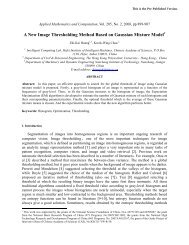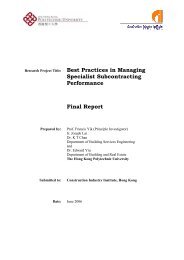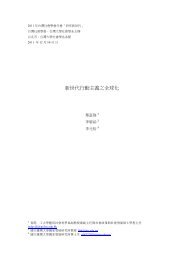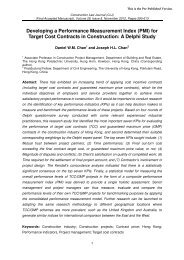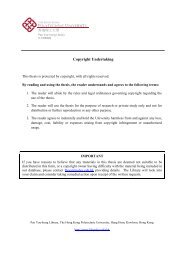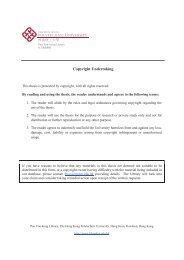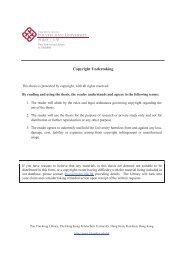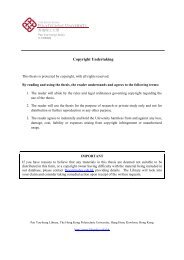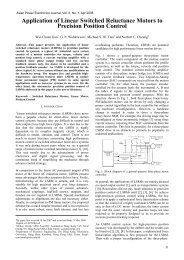Water-induced degradation in lead zirconate titanate piezoelectric ...
Water-induced degradation in lead zirconate titanate piezoelectric ...
Water-induced degradation in lead zirconate titanate piezoelectric ...
You also want an ePaper? Increase the reach of your titles
YUMPU automatically turns print PDFs into web optimized ePapers that Google loves.
3588 Appl. Phys. Lett., Vol. 80, No. 19, 13 May 2002 Chen et al.<br />
dc voltages were removed after some designated periods of<br />
time and the samples were taken out, washed and dried.<br />
Impedance/phase versus frequency spectra of the PZT r<strong>in</strong>gs<br />
were measured by an Agilent 4294 A impedance analyzer.<br />
I – V characteristics of the r<strong>in</strong>gs were recorded by a Keithley<br />
237 dc source/measure unit. A ZJ-3D piezo d 33 meter manufactured<br />
by Beij<strong>in</strong>g Institute of Acoustics, Ch<strong>in</strong>a was used<br />
to measure the <strong>piezoelectric</strong> charge coefficient d 33 of the<br />
r<strong>in</strong>gs. Microstructural analyses were carried out by a scann<strong>in</strong>g<br />
electron microscope STEROSCAN 440.<br />
Microstructural analyses showed that the PZT r<strong>in</strong>gs were<br />
of a very dense microstructure. It was difficult for water to<br />
permeate <strong>in</strong>to the r<strong>in</strong>gs. Accord<strong>in</strong>gly, no noticeable change<br />
could be observed <strong>in</strong> the properties of the r<strong>in</strong>gs after the first<br />
treatment. It should be po<strong>in</strong>ted out that some r<strong>in</strong>gs have been<br />
immersed <strong>in</strong> the NaOH solution for 20 days. These facts<br />
suggest that, <strong>in</strong> the absence of an electric field, the dilute<br />
NaOH solution does not <strong>in</strong>fluence the PZT r<strong>in</strong>gs by permeation.<br />
In contrast, serious <strong>degradation</strong> occurred <strong>in</strong> those<br />
samples treated by hydrogen charg<strong>in</strong>g. The PZT r<strong>in</strong>gs vibrate<br />
<strong>in</strong> the thickness mode when they are used <strong>in</strong> a wire bond<strong>in</strong>g<br />
mach<strong>in</strong>e. The impedance/phase spectra of the thickness vibration<br />
mode for an as-received PZT r<strong>in</strong>g is shown <strong>in</strong> Fig.<br />
1a. The peak of m<strong>in</strong>imum impedance corresponds to the<br />
resonance of the thickness vibration mode. The impedance<br />
and the frequency of the peak are the resonance impedance<br />
Z r and the resonance frequency f r , respectively. The peak of<br />
maximum impedance corresponds to the anti-resonance of<br />
the thickness vibration mode. The impedance and the frequency<br />
of the peak are the anti-resonance impedance Z a and<br />
the antiresonance frequency f a , respectively. The r<strong>in</strong>g was<br />
then placed <strong>in</strong> 0.01 M NaOH solution and subjected to a dc<br />
voltage of 3 V between its silver electrode and the anode <strong>in</strong><br />
the solution. Under this voltage the cathodic current density<br />
was around 0.2 mA/cm 2 . The treatment was <strong>in</strong>terrupted several<br />
times and the r<strong>in</strong>g was taken out for measurement after<br />
be<strong>in</strong>g dried. The impedance/phase spectra of the thickness<br />
vibration mode obta<strong>in</strong>ed <strong>in</strong> these measurements are shown <strong>in</strong><br />
Figs. 1b, 1c, and 1d. For these measurements, the hydrogen<br />
charg<strong>in</strong>g treatment was conducted for 40, 80, and 120<br />
h, respectively. It is clear that with <strong>in</strong>creased hydrogen charg<strong>in</strong>g<br />
time, the resonance impedance Z r <strong>in</strong>creases while the<br />
antiresonance impedance Z a decreases. Both the resonance<br />
frequency f r and the antiresonance frequency f a are shifted<br />
slightly to higher frequency after the hydrogen charg<strong>in</strong>g. The<br />
<strong>degradation</strong> of this PZT r<strong>in</strong>g can also be seen <strong>in</strong> the changes<br />
<strong>in</strong> the mechanical quality factor Q m , which is the reciprocal<br />
of the mechanical loss, and the dielectric loss at 1 kHz, as<br />
shown <strong>in</strong> Fig. 2. The mechanical quality factor Q m was calculated<br />
by the equivalent circuit method with the Agilent<br />
4294 A impedance analyzer. 8 The mechanical quality factor<br />
Q m decreases dramatically while the dielectric loss <strong>in</strong>creases<br />
considerably by the treatment, which implies that the treatment<br />
will cause more mechanical loss and more dielectric<br />
loss when the r<strong>in</strong>g is used <strong>in</strong> a wire bond<strong>in</strong>g mach<strong>in</strong>e.<br />
As no <strong>degradation</strong> occurred <strong>in</strong> those samples immersed<br />
<strong>in</strong> NaOH solution without the application of dc voltages, it<br />
can thus be concluded that the electrochemical reactions <strong><strong>in</strong>duced</strong><br />
by the dc voltages are the cause of the <strong>degradation</strong>.<br />
FIG. 1. Impedance/phase vs frequency spectra of the thickness vibration<br />
mode of a PZT r<strong>in</strong>g: a as-received, b after 40 h hydrogen charg<strong>in</strong>g, c<br />
after 80 h hydrogen charg<strong>in</strong>g, d after 120 h hydrogen charg<strong>in</strong>g.<br />
Hydrogen was evolved on the silver electrode of the PZT<br />
r<strong>in</strong>gs when dc voltages were applied, which can be written as<br />
H 2 Oe →OH H ads ,<br />
1<br />
H ads H ads →H 2 ,<br />
2<br />
where H ads represents an adsorbed hydrogen atom. Hydrogen<br />
atoms are very reactive and exist only as <strong>in</strong>termediate<br />
products. 9 Some of them may react with other matter encountered<br />
<strong>in</strong> their path, although most of them comb<strong>in</strong>e with<br />
one another to form hydrogen molecules. Some researchers<br />
have shown that atomic hydrogen generated by electrolysis<br />
of water can diffuse <strong>in</strong>to ceramics and <strong>in</strong>duce reduction reactions<br />
at ambient temperature, which greatly changes the<br />
properties of the ceramics. 5,6 The <strong>degradation</strong> of the PZT<br />
r<strong>in</strong>gs <strong>in</strong> this study can also be expla<strong>in</strong>ed by the reduction<br />
reaction of hydrogen atoms.<br />
Accord<strong>in</strong>g to some previous studies, the reduction reaction<br />
of atomic hydrogen results <strong>in</strong> the formation of charge



